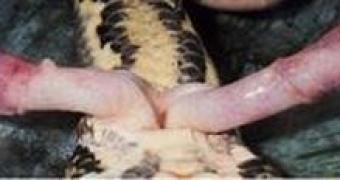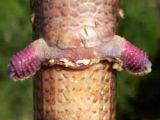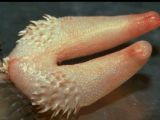Guess what do we have here? Some kind of odd mushroom? Or a gut maybe? No, no, no...
You little jealous dude ...it's exactly what you first thought: a double penis. Each penis on this pair is called a hemipenis (plural hemipenes). This type of copulatory organs belong to the males of the reptilian group of squamata ("scaly"): snakes, lizards and amphisbaenas.
Resting hemipenes are held inverted inside the cloacae, and during the copulation act, erectile tissue, like that in the mammalian and human penis, everted the hemipenes in erection. espite this nature's generosity, only one "gun" is used at a time, and scientific research revealed that males alternate the use of their weaponry between copulations.
This is because every hemipenis also ejaculates a gelatinous "mating plug", which delays remating by female, and continuous use of only one arm would deplete it of ammunition.
There is considerable inter-specific variation in hemipenial structure, involving size, asymmetry and simplification, which is described systematically and differences in hemipenis' structure can differentiate species.
In many snakes, the hemipenis possesses spines or hooks, in order to anchor the male within the female, as the lack of legs impedes males to grip the females. As if this had not been enough, some species even have forked hemipenes (each hemipenis has two tips).
Because hemipenes are everted and inverted, their anatomical structure is not like that of mammal penis: they do not have a completely enclosed channel for sperm conduction, but a seminal groove which seals as the erectile tissue the hemipenes.
In snakes, where there is asymmetry between many paired organs (kidney, testes), was observed an asymmetry between the hemipenes as well. In some lizards, the distal lobes of the retracted hemipenis are complexly folded and there is a well-defined supporting structure of dense connective tissue, the armature.

 14 DAY TRIAL //
14 DAY TRIAL // 

